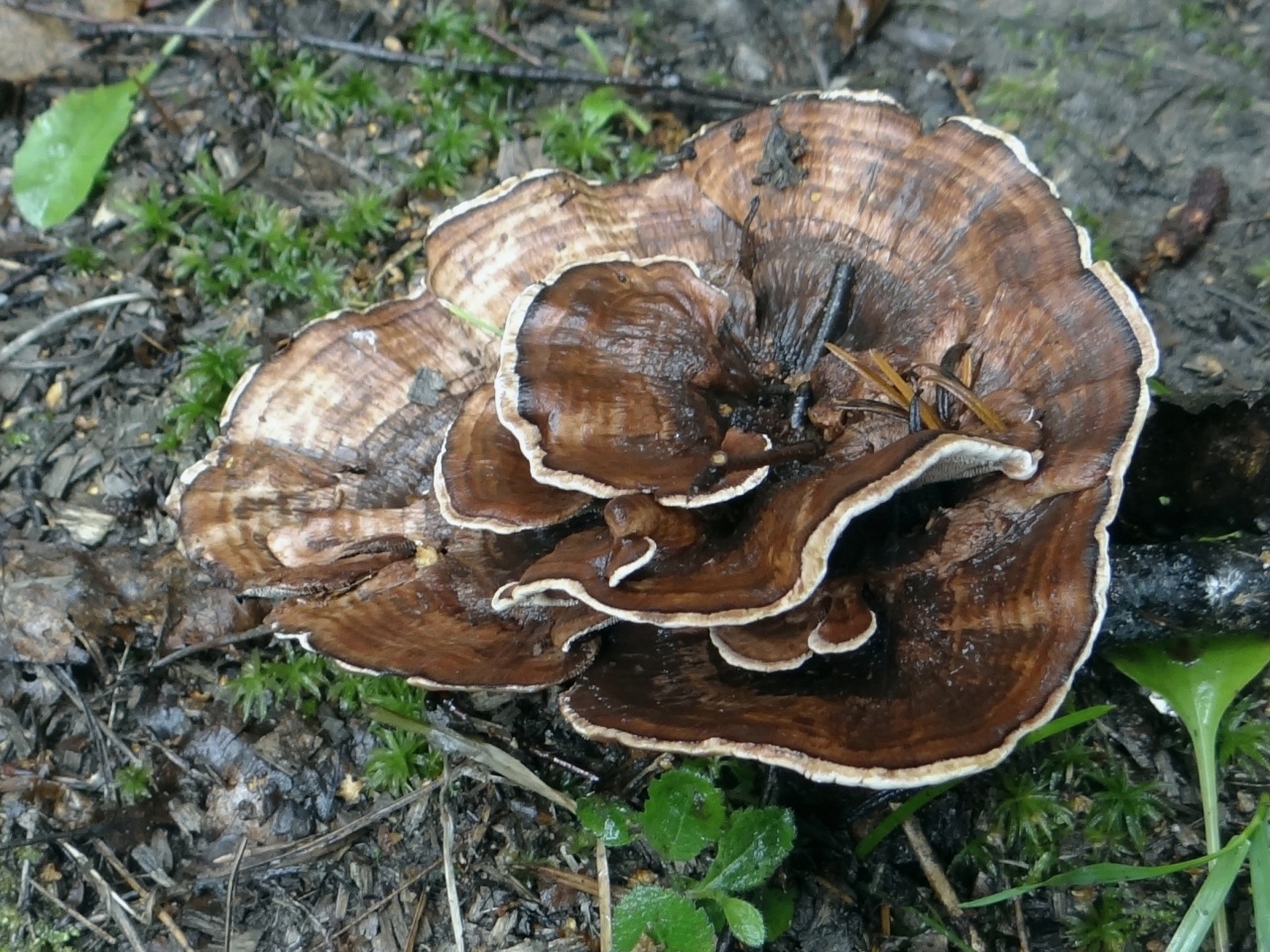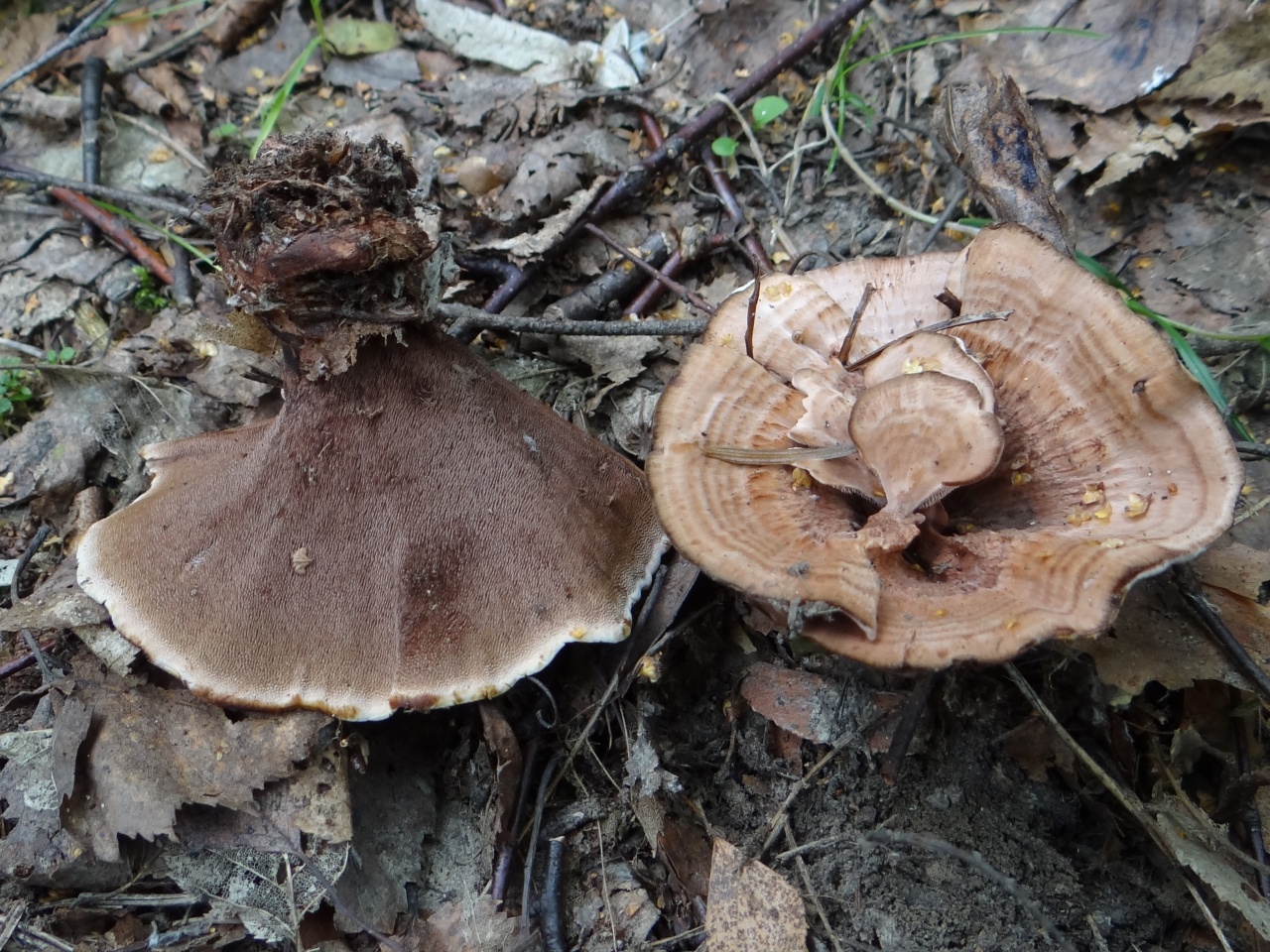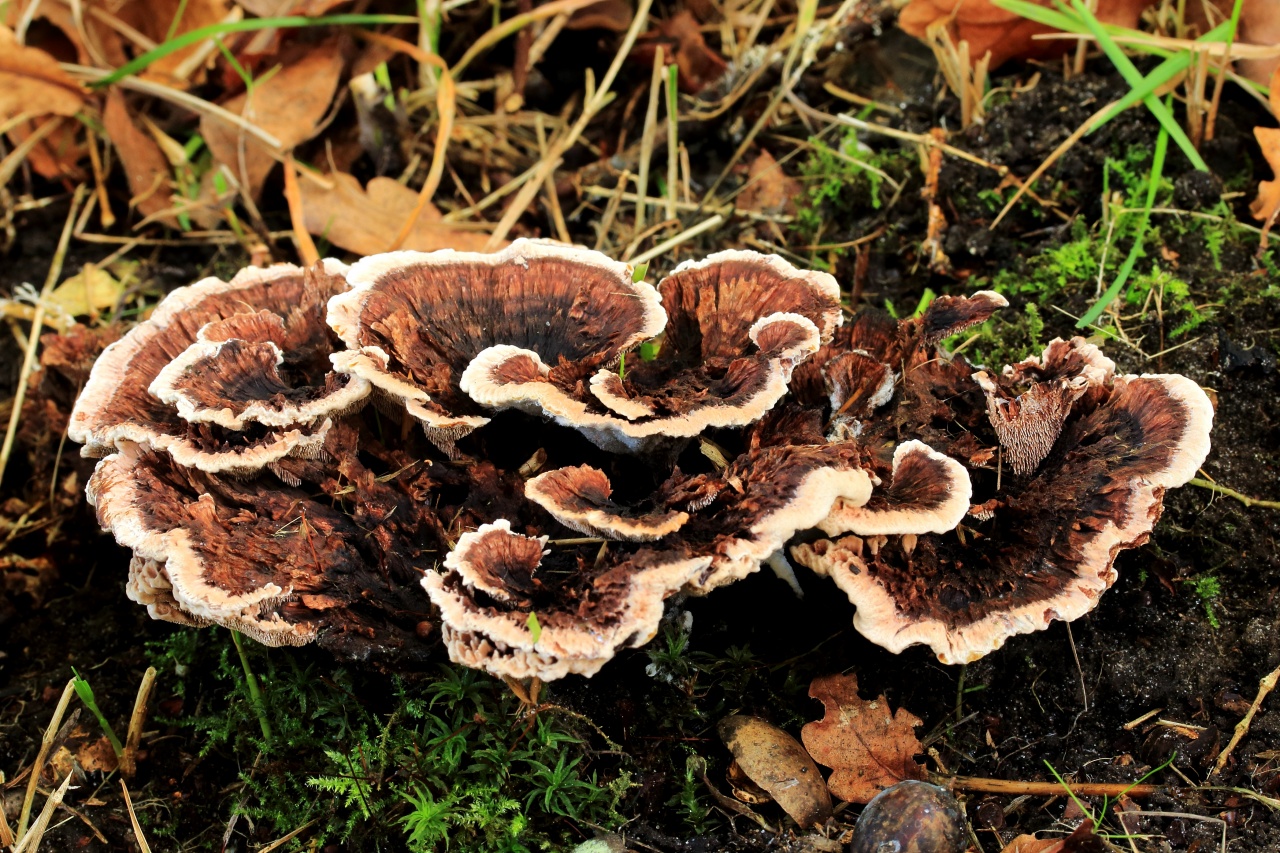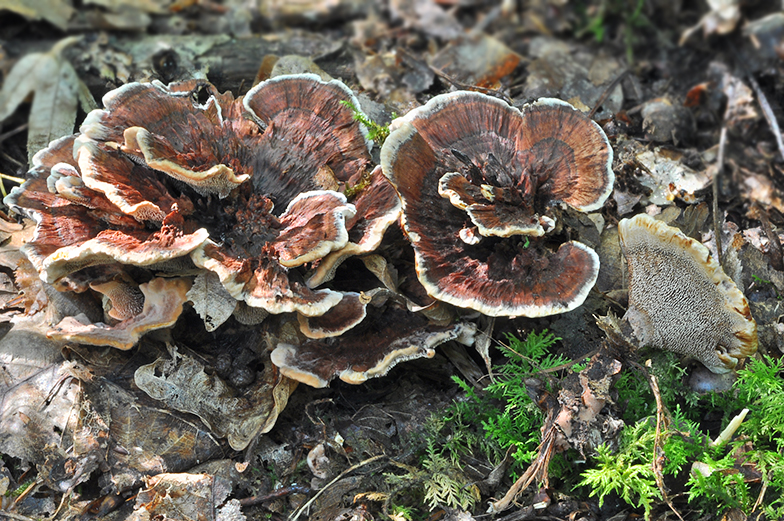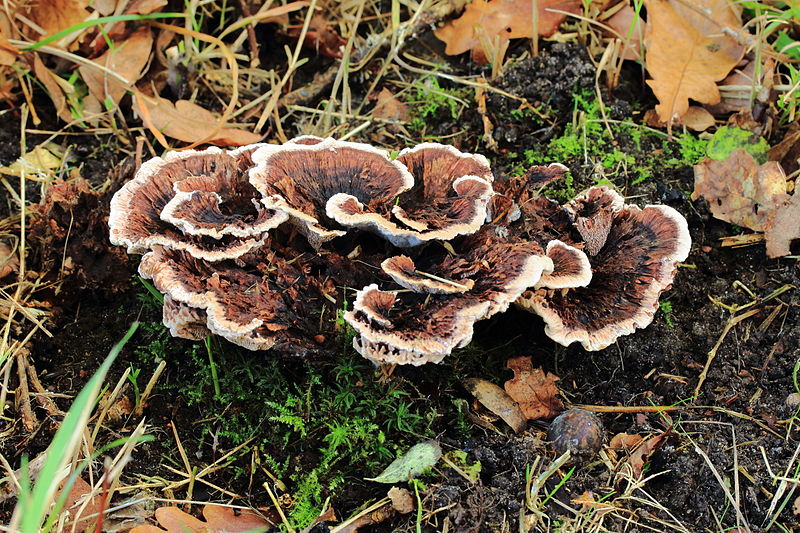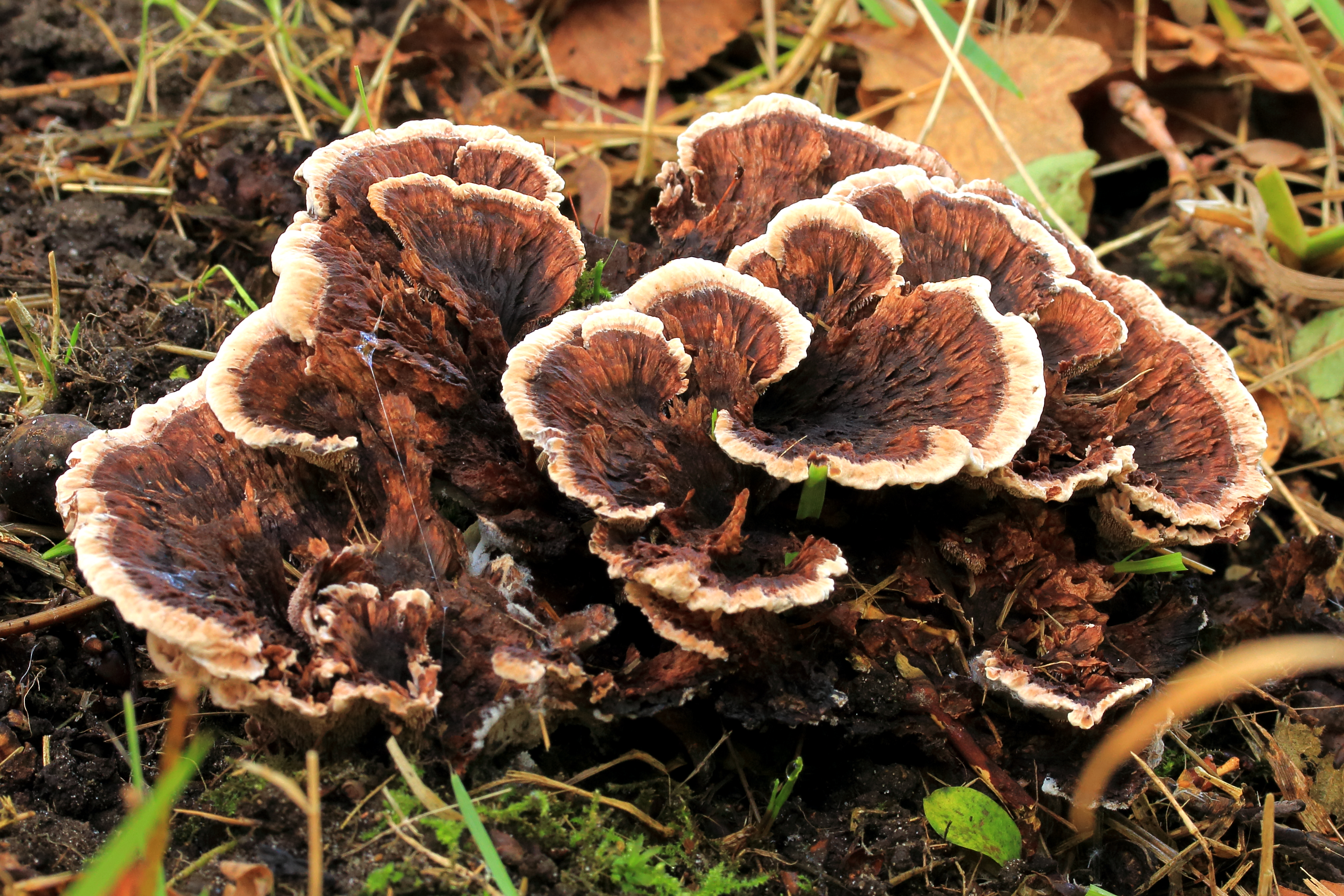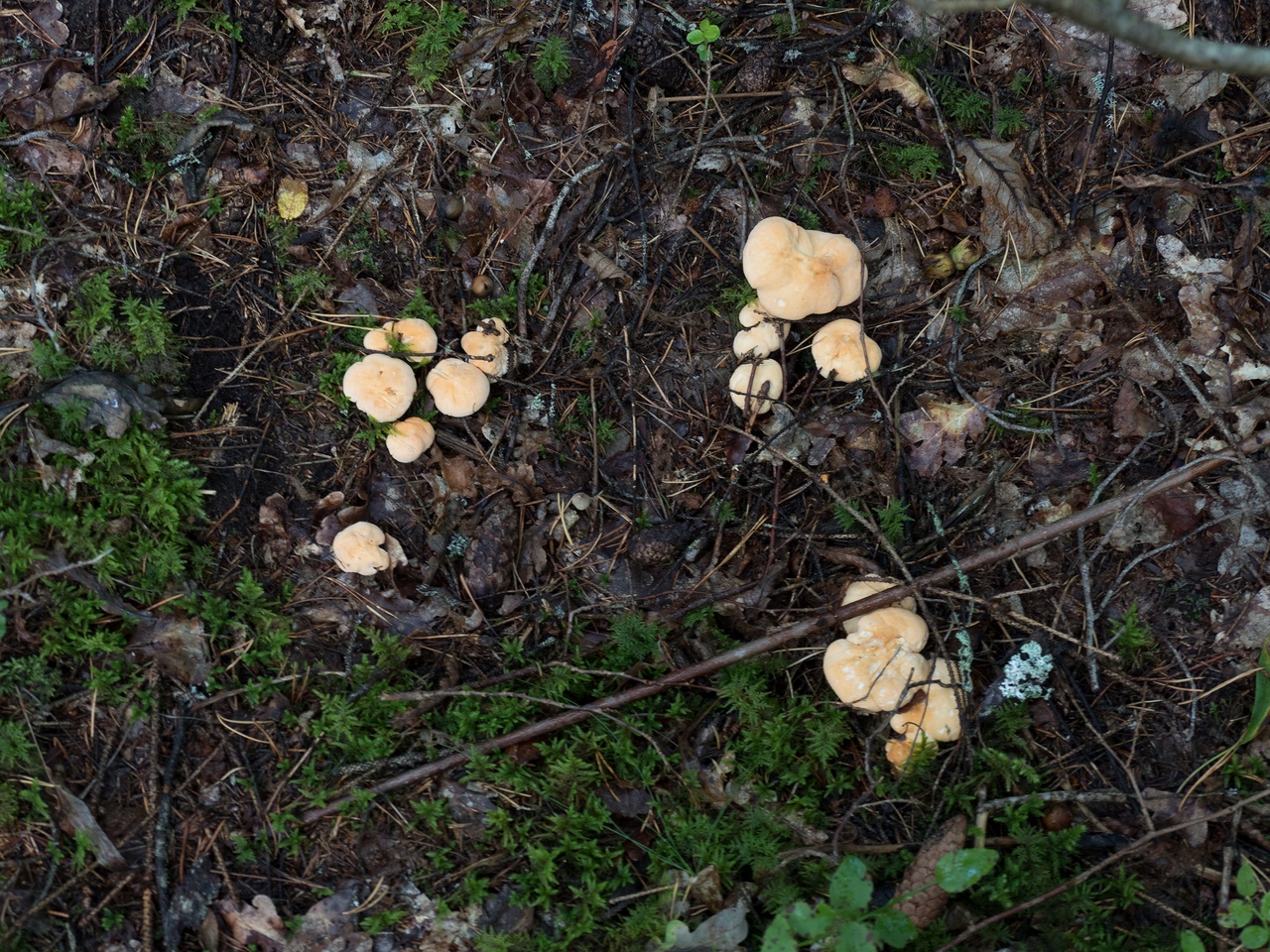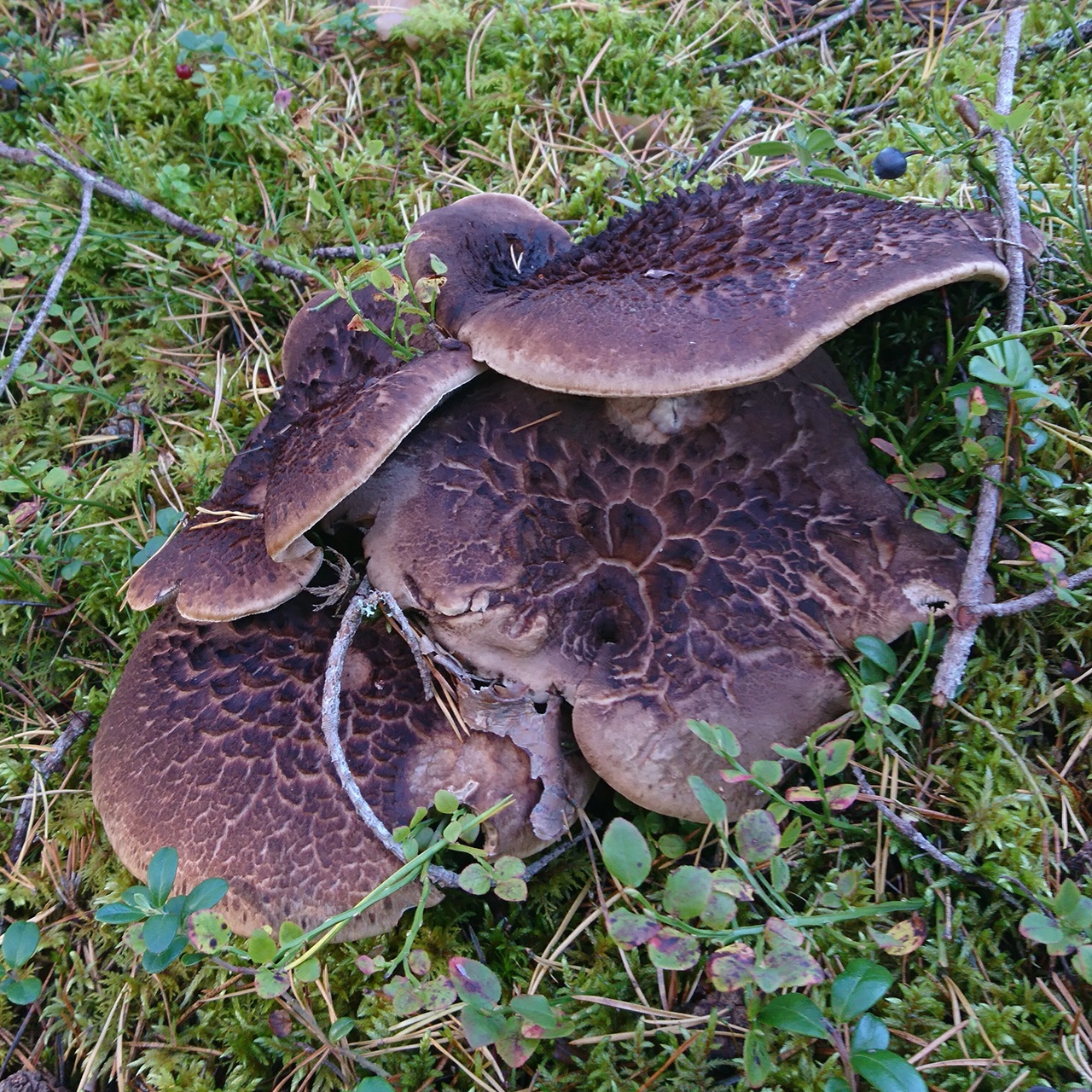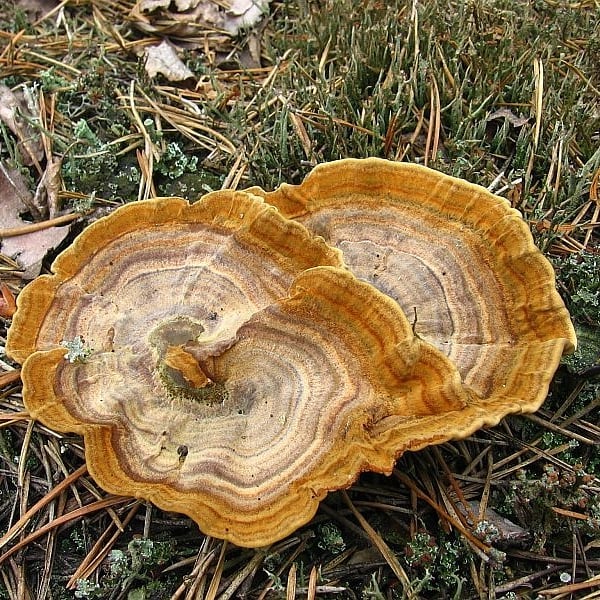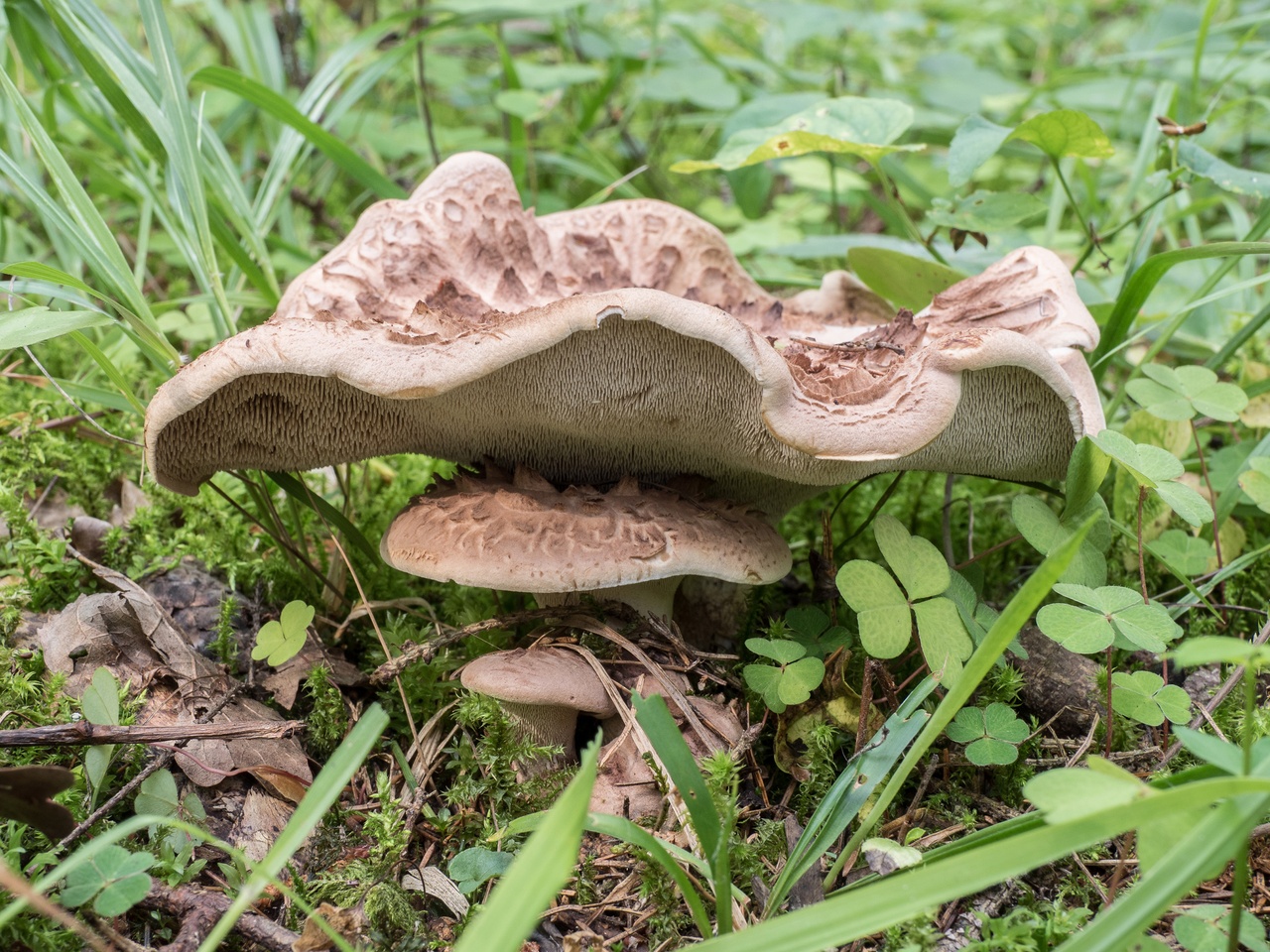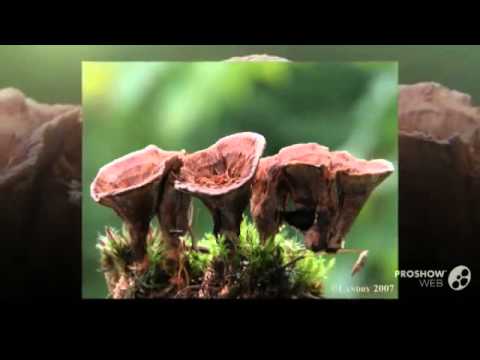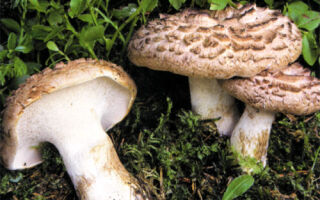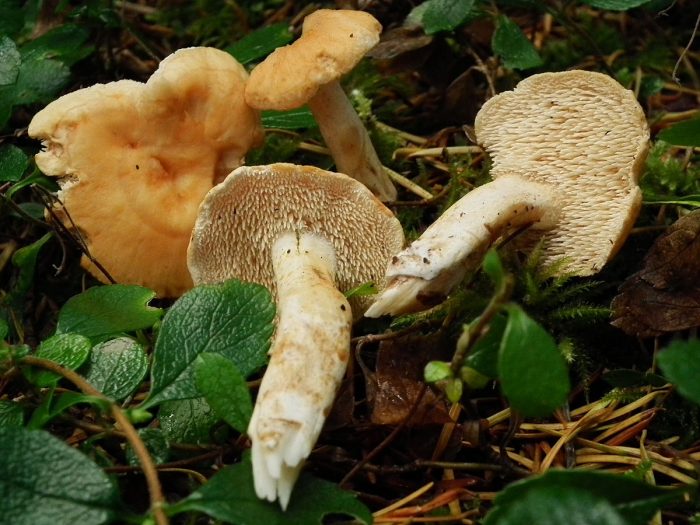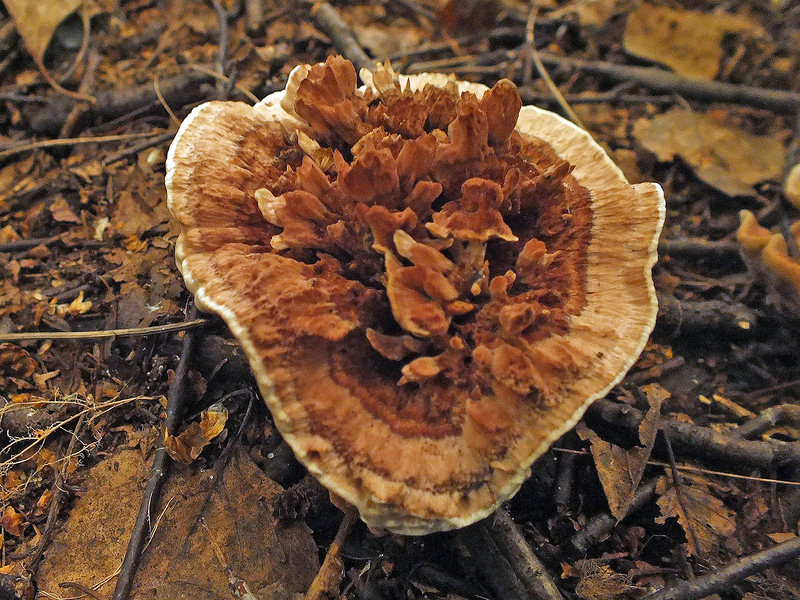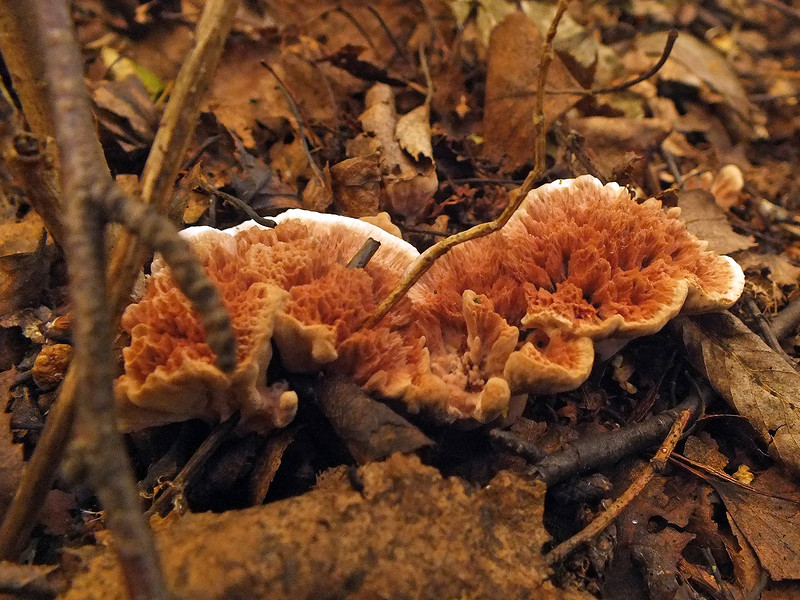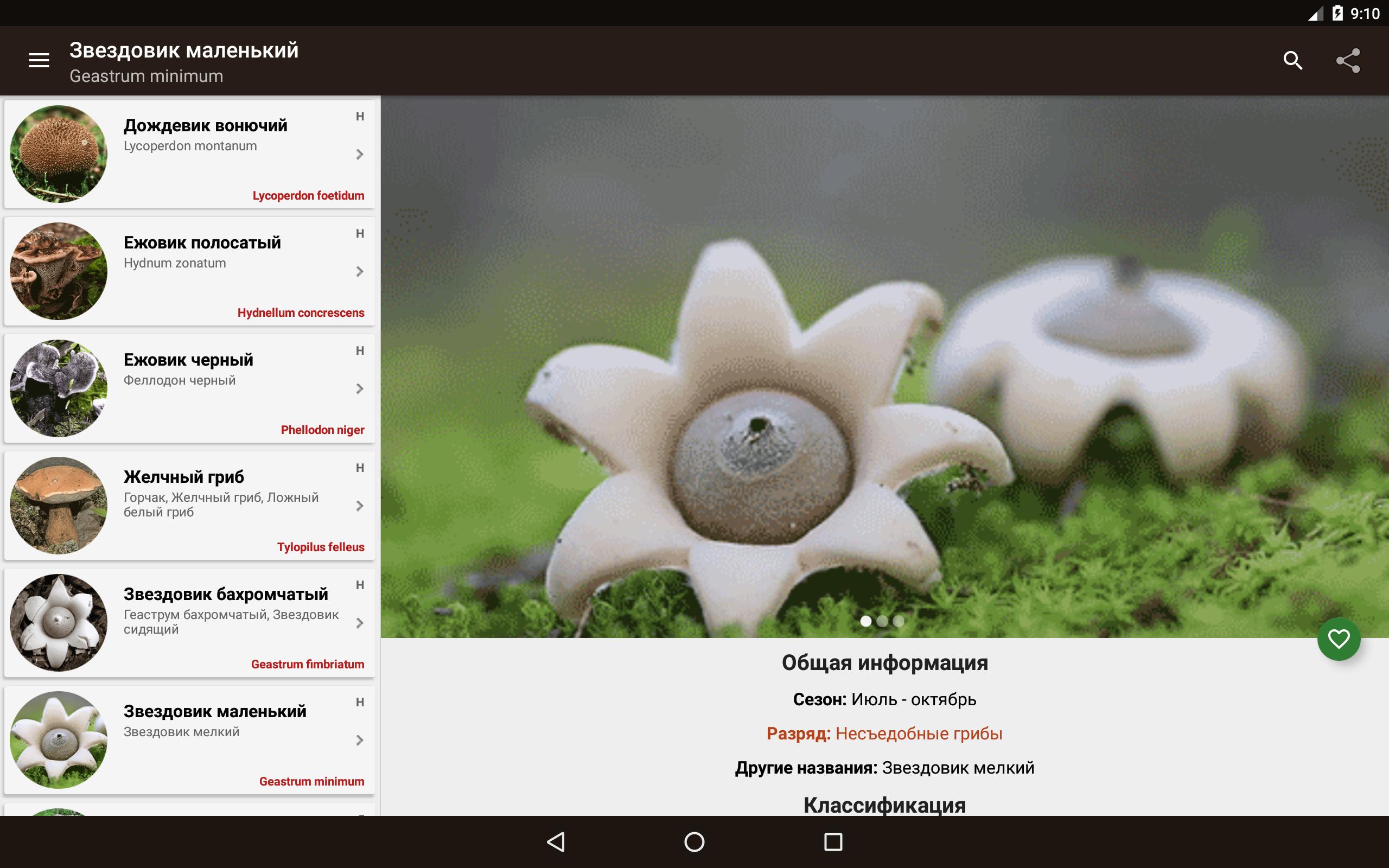Hericum motley, or sarcodon
This mushroom is not related to the yellow hedgehog. As the saying goes, "not only not a relative, but not even a namesake."
The motley hedgehog belongs to the genus Sarkodon of the Bunkerov family. The Latin name for the mushroom is Sarcodon imbricatus. The name "motley sarcodon" quite often sounds nowadays even in Russian.
Also called the scaly hedgehog, the tiled hedgehog. In some places they are called "chicken" or "hawk". I don't even try to explain the last two names - nothing comes to mind.
Herz's Man is called for the underside of the cap covered with light gray thorns. Such is the hymenophore (spore-bearing layer) of the variegated hedgehog. And only in this way the mushroom is similar to the yellow hedgehog. Spikes replace the tubes or plates that are more familiar to us.
Instead of plates or tubes, the variegated hedgehog has thorns
The cap can reach a diameter of 25 cm. At first it is dome-shaped, then it becomes convex-flat, and later it can become concave.
The surface of the cap is covered with large brown scales. They are arranged concentrically, quite tightly adjoining one to one, forming a kind of shingles. One edge of each scale is raised. But the mushroom still does not look "shaggy".
The surface of the scales is colored in darker tones. Sometimes they are almost black. But, rising above the surface of the cap, the scales reveal a lighter, brown or light brown skin. The mushroom looks variegated, which explains its specific name.
The stem is dense, somewhat thickened at the base. The color of the leg is gray-brown, sometimes even with a purple tint. The leg of young mushrooms is solid, and of old ones it is hollow inside.
It looks like a motley one from below
The flesh of the mushroom is white, with age it becomes light gray. The older the fruiting body of variegated hedgehog, the harder it is. In addition, with age, the mushroom becomes bitter.
The motley hedgehog grows throughout the forest belt of Russia and European countries (in temperate latitudes). Somewhere the mushroom is more common, somewhere less common. But its area is huge.
Mycorrhiza forms with conifers. Prefers sandy soils. In such conditions, mainly Scots pine grows in our country, and the motley hedgehog is one of the constant companions of this tree. Most often it can be found in pine forests.
Fruiting bodies are formed from the middle of summer, and the limit to this is usually set by autumn frosts. There are no "doubles" in the motley hedgehog, and there is no need to be afraid to confuse it with some kind of poisonous or inedible mushroom. But at a "mature age" the mushroom itself becomes poorly edible due to its hardness and bitterness.
How is variegated hair man used?
Usually only young fruiting bodies are collected, which have not yet fully developed. They have white flesh and a solid leg. Mushrooms, like the one in my photo, are no longer worth taking. In addition, the fruit body is damaged by insect larvae.
In this form, the mushroom is no longer taken
Sheep's mane is fried, sometimes salted hot (after ten minutes of boiling) and pickled. You can also dry it and then grind it into a powder used as a fragrant seasoning.
The mushroom has medicinal properties. But, like many other mushrooms, variegated black man's mane has never been used in folk medicine.
The substances of the black barnacle, extracted by scientists using various methods, have an antimicrobial effect on many types of bacteria, including Staphylococcus aureus and Salmonella.
Laboratory studies also show that preparations from this mushroom can be useful for cancer, stomach cancer, and leukemia.
However, I will clarify once again - these are the results of studies carried out, so to speak, "in vitro" ("in vitro"). Practical experience, real statistics of cures are not yet available.
But to collect the variegated hedgehog for culinary purposes, to use it for food - and why not?
Spotted Hericium (Sarcodon Imbricatus)
Other names of the mushroom: Hericium flake
Synonyms:
- Hericium tiled
- Hericium scaly
- Sarcodon tiled
- Variegated sarcodon
- Kolchak
- Sarcodon squamosus
Hat: at first the hat is flat-convex, then it becomes concave in the middle. In diameter 25cm. Covered with tiled lagging brown scales. Velvety, dry.
Flesh: thick, dense, whitish-gray in color with a spicy odor.
Disputes: on the underside of the cap there are densely spaced conical spines, pointed thin, about 1 cm long. At first, the thorns are light, but with age they become darker.
Spore powder: brown.
Leg: 8 cm long. 2.5 cm thick. Solid, smooth cylindrical shape of the same color with a cap or slightly lighter. Sometimes there are specimens with a purple stem.
Distribution: Variegated Hericium is found in coniferous forests. Growing time is August - November. A rather rare mushroom that grows in large groups. Prefers dry sandy soils. Distributed in all forest zones, but not equally, in places it is absent altogether, and in places it forms circles.
Similarity: The variegated Hericium can only be confused with similar species of Hercules. Related species:
- Finnish Hericium, characterized by the absence of large scales on the cap, dark pulp in the stem and an unpleasant, bitter or peppery taste
- Hericium is rough, which is slightly smaller than motley, with a bitter or bitter aftertaste and, like the Finnish, dark flesh in the leg.
Edible: The mushroom is good for human consumption. Young mushrooms can be eaten in any form, but tastes best when fried. The bitter taste disappears after boiling. The motley herringbone has an unusual spicy smell, so not everyone will like it. Most often, it is used as a condiment in small quantities.
Video about the Motley Hericium mushroom:
Remarks: Sarcodon imbricatus grows in the darkest and most inaccessible places on dry sandy soils.
Leena Riihelä, a super-master at dyeing wool with natural dyes, writes on her blog:
Here on WikiMushroom, Sarcodon squamosus is spelled out the old fashioned way, as a synonym for Sarcodon imbricatus. For the time being, these barnacles remain to be defined as one species, since the exact definition will be extremely difficult, and from a culinary point of view, there is not much difference.
Mushroom photo Hericium is variegated from questions in recognition:
LAT
Specifications:
| Group: | Needle |
|---|---|
| Plates: | Whitish gray to dark gray |
| Colour: | Brownish, Black with brown |
| Info: | Thickening at the base of the leg |
Systematics:
| Department: | Basidiomycota (Basidiomycetes) |
|---|---|
| Subdivision: | Agaricomycotina (Agaricomycetes) |
| Class: | Agaricomycetes (Agaricomycetes) |
| Subclass: | Incertae sedis (indefinite) |
| Order: | Thelephorales |
| Family: | Bankeraceae (Banker) |
| Genus: | Sarcodon (Sarcodon) |
| View: | Sarcodon Imbricatus |
In cooking
This mushroom has been highly appreciated by French culinary experts. In France, it is classified as a delicacy. The hedgehog is used in recipes for preparing side dishes, snacks and main dishes. Famous chefs prepare sauces with it, delicious dressings for soups.
The taste of young mushrooms resembles honey agarics, and tall hedgehogs are almost indistinguishable from chanterelles. Therefore, if the question arises of how to cook them, then exactly the same.
Among lovers of quiet hunting, there is an opinion that strongly grown mushrooms are not suitable for consumption, but this is more a question of proper preparation, where you can discover a delicate taste and delicate aroma.
To improve the taste and impart softness, boil the hedgehog in salted water before cooking. Although they are great for simple heat. Here's one quick way:
- Process mushrooms: rinse in running water, cut off excess.
- Preheat a skillet with oil.
- Slice and pour into a hot skillet.
- Fry over low heat, add onions after 5-10 minutes.
- Fry until tender.
It is good to stew the herd's mane with sour cream sauce.The mushrooms should be cut into large cubes, as they greatly decrease in size during the cooking process. For the sauce, add garlic, herbs and a pinch of salt to the sour cream. Add the sour cream sauce to the mushrooms a couple of minutes until tender.
You might also like:
Camelina mushrooms: benefits and harms. Camelina recipes
You can recognize this mushroom by its cap. It has a convex or irregular shape, matte cream, 3-12 cm in diameter. If it is damp outside, the hat may take on an orange or yellow-brown tint; in dry weather, the color becomes whitish. There are outgrowths-needles on the underside of the cap, which easily crumble when touched.
Description of the mushroom:
- the cap is pubescent, the edges are bent down;
- the leg is cylindrical, up to 2.5 cm wide and 7 cm long, it is lighter behind the cap;
- the pulp is dense, light cream, in old mushrooms it acquires a reddish tint;
- pleasant fruity smell;
- sour taste.
Mushrooms grow near coniferous and deciduous trees, mainly in lighted areas.
Harm of yellow hedgehog and contraindications
One might say, the black man's men do not bring harm. They have no poisonous counterparts and it is difficult to confuse them with mushrooms hazardous to health. However, adult mushrooms have a bitter taste, which is alarming for many. In addition, inexperienced mushroom pickers, out of ignorance, often consider them to be toadstools, and therefore trample and break. Of course, like any other mushrooms, yellow hedgehogs accumulate toxins and other harmful substances, so it is better to collect them in ecologically clean areas. It is contraindicated to consume such mushrooms for young children, since such a product is considered difficult for the child's body.
Hericium bleeding - Hydnellum peckii
Written by Nikolay Budnik and Elena Meck.


2. Blood-red drops appear on a dirty white background.


4. At the beginning there are many drops.

5. Then there are fewer and fewer of them.

6. Finally, the droplets dry out as dark red spots.

7. Sometimes the bleeding hedgehog has an even off-white color.






13. We have always found him in a dry pine forest.



16. Its surface is matte and slightly rough.

16a. The droplets come out in accordance with physical laws. The gutting process is much more common than meets the eye. Sometimes we see not dew on young grass, but droplets of gutted juice.

17. Mushroom caps often “overgrow” everything that is in their way ..

17a. Here we see lingonberry bushes surrounded by a mushroom.

18. Mushroom caps can be almost white.

19. . or maybe brown-red.

20. But “bloody tears” can be present on the cap of any color.


23. In young mushrooms, they are light.

24. In old mushrooms, the spines darken.

25. The thorns go down the leg.

26. Because of these spines, the mushroom is called a hedgehog.


28. It gets longer with age.

29. The leg is dark brown and covered with growths.


31. Bleeding Hericium is inedible.



Description of species and their photos
All hedgehogs have similar species features, and any of them must be heat treated during cooking.
Edible
Let's consider the types in more detail:
- Yellow (lat.Hydnum repandum) is an edible representative of the genus Hydnum of the Ezovik family. It has a yellowish cap with a smooth surface and edges curved downward, which, due to its irregular shape, often grows together with the caps of neighbors. The pulp is whitish, dense and has a pleasant smell. Grows from July to October in deciduous, coniferous and mixed forests.
- White (Hydnum albidum) is practically indistinguishable from yellow. Its cap is slightly lighter and larger in diameter (up to 17 cm), sometimes with blurred grayish or yellowish spots. It prefers to live in damp places, moss cover, deciduous and coniferous trees. But the main condition for its growth is calcareous soil.
- Antennae (Hericium cirrhatum) grows in small tiers on tree trunks and stumps and is listed in the Red Book. Mostly found in mixed forests. Fruiting from late summer to mid-autumn.The hemispherical fruit body consists of several layers, white-cream in color. It can reach a height of 15 cm. It is a bit like climacodon.
- The comb (Hericium erinaceus) is protected in many countries. Its fruiting body is irregular in shape and has no legs. Consists of long hanging threads, forming a ball, "beard". For this reason, the people come across the name "grandfather's beard". The pulp is white, soft and fleshy. Distributed in the Khabarovsk Territory, the Amur Region, in the north of China, in the Primorsky Territory, Crimea and the foothills of the Caucasus. Prefers to grow on live or dead oak trunks.
- Alpine (Hericium flagellum) in appearance is easily confused with coral. The fruiting body is formed by many branches growing from one common short stalk and reaches 30 cm in height. Young specimens are light, whitish in color. Grows in mountainous areas and foothills, especially firs. The peak of the harvest season falls in late summer - early autumn.
- Coral (Hericium coralloides) - the brightest and most beautiful among its relatives, is a Red Book specimen. Its fruiting body has a bushy, branched structure with dense and brittle thorns on the surface. The color is white or cream. The firm and fibrous pulp has a pleasant mushroom aroma. It grows on stumps or in the deciduous canopy of species such as birch, aspen and oak.
Conditionally edible
A few more species of hedgehogs are suitable for eating, but due to bitterness, they require prolonged heat treatment, therefore, they are classified as conditionally edible:
- Red-headed (Hydnum repandum) grows mainly in the wild. Its cap is wavy in shape, has a characteristic reddish-red color and is rather brittle at the edges. The cylindrical leg is weakly attached to the soil, so the mushroom can be easily separated from the ground. Prefers to live in mixed forests, in moss or low grass.
- Variegated sarcodon (Sarcodon Imbricatus) is a rather rare species, found mainly in coniferous forests and in dry sandy soils. Its cap is covered with brown tile-like scales, lagging behind the surface, and the flesh is dense, off-white in color and has a pleasant smell. The smooth stem of a cylindrical shape, 2.5 cm thick and about 8 cm long. The smell of the motley hedgehog is rather sharp and spicy, so I often use it as a seasoning for dishes.
- The gelatinous pseudo-beetle (Pseudohydnum gelatinosum) is a rather rare specimen, but it can be found in the remains of coniferous and deciduous trees in America, Australia and Northern Europe. The pulp of the mushroom is jelly-like and soft. Although it is considered edible, it is not of any value from a culinary point of view due to its neutral taste.
Inedible
All other representatives of the barnacle mushroom group are inedible, as they are too bitter and may have an unpleasant, pungent odor. These include:
- rough (unkempt);
- felt;
- black;
- white-legged;
- striped;
- Finnish;
- the climacodon is beautiful;
- climacodon northern.
Growing
You can grow a hedgehog in the country. Sowing is carried out from April to October in the open air; it is possible to grow in closed myceliums all year round. Instead of soil, wood is used: coniferous or deciduous, depending on the type of fungus. Wet logs of fresh felling without branches will do. In length no more than a meter and a diameter of 15-20 centimeters. The dry material must be soaked for a couple of days, then let the excess water drain off.
The logs require preparation: drill holes 4 cm deep, 0.8 cm in diameter in a checkerboard pattern every 10 cm. With sterile gloves, mushroom sticks are tightly inserted into the holes. The tree is wrapped in plastic wrap, in which small slots are made for air to enter. Then they are placed in a warm and shady place and the moisture content of the wood is maintained by watering 2-3 times a week.
After the appearance of the mycelium filaments, the logs are moved into water for 24 hours. Then they are exposed vertically in a bright place.For the winter, myceliums are sprinkled with dry leaves or transferred to a cellar.
The first crop will be harvested no earlier than six months later.
Species of the barnacle mushroom
Yellow Hericium (Hydnum repandum)
The hat is 3-12 cm in diameter, fleshy, dry, dense, the surface is uneven, bumpy, the shape is irregular. A young mushroom has a slightly convex cap, the edges are bent down, the surface is velvety; as the mushroom matures, it flattens, the middle is crushed in, and the edge becomes wavy. Often grows together with the caps of neighboring mushrooms. The color of the cap is from light ocher and pinkish-yellow to reddish-orange and light hazel; darkens when pressed, and becomes light in dry weather. The pulp is dense, brittle, white or yellow, darkens at the break, the smell is pleasant, fruity. The old mushroom has a hard, bitter taste. The leg is 3-5 cm in length and 1.5-4 cm in thickness, dense, solid, cylindrical, widened at the base. The surface is smooth, dry, white or yellow, darkens with age.
The fungus grows in deciduous and coniferous forests, loves moss cover. It is found in the temperate zones of Eurasia and North America, as well as in Siberia and the Far East.
A yellow hedgehog appears at the beginning of summer and grows until the first autumn frosts.
Red-haired or reddish-yellow Hericium (Hydnum rufescens)
The cap is smooth, irregular, reddish-orange in color. The edge is tucked up. Below the cap is covered with brittle spines. The leg is thick and dense. The pulp is dense, fleshy, cream-colored in structure, turns orange when pressed.
The mushroom grows in mixed and coniferous forests, in autumn.
Spotted Hericium (Sarcodon imbricatus)
The hat is 5-10 cm in diameter, dry, hard. The shape is flat-convex, in an old mushroom with a concave center; the edge is wavy. From above, the cap is covered with large scales that look like shingles. The color of the cap is brownish or grayish-brown, the scales are dark. The young mushroom has a velvety surface, the old one is smooth. The flesh is whitish in color, becomes dirty gray as it grows; in a young mushroom it is dense and juicy, in a mature mushroom it is dry and solid. Spicy aroma, taste with bitterness. The leg is dry, thick, cylindrical, widened downward; 2-5 cm long, 1-1.5 cm thick. The color of the leg is grayish, at the base it is brown.
Grows in dry coniferous forests, sometimes in mixed, on sandy soils, singly and in groups.
Fruiting occurs from August to October.
Conditionally edible mushroom. Young mushrooms are salted, pickled, dried, used as a seasoning. Old mushrooms are not used for food.
Hericium coralloides
The fruit body looks like a branch of a coral, branched, white or pinkish in color. The flesh of a young mushroom is white, gradually turns yellow, the smell is not pronounced. It grows on the trunks and stumps of dead deciduous trees (aspen, elm, oak, birch).
Young mushrooms are considered edible, but they are not harvested, since they are listed in the Red Book.
Hericium erinaceus (Hericium erinaceus)
The fruiting body is up to 20 cm, weighs about 1.5 kg, the shape is round or irregular, from white to beige. The flesh is whitish, fleshy. Turns yellow when dry.
A rare species that grows on the trunks of still living or dead deciduous trees (oak, beech, birch) in the Amur Region, Khabarovsk Territory, Primorsky Territory, China, the Caucasus and Crimea.
The season runs from early August to October.
Hericium curly, or barbel hedgehog (Hericium cirrhatum)
The fruiting body is capped, white or pinkish, turns yellow with age. From above, the cap is covered with spines or felt. Fringed edge. The pulp is thick, soft, white or pinkish, turns yellow when dry.
Only a young mushroom is edible.
Grows in July-September in deciduous and mixed forests of the Northern Hemisphere species.
Pseudohydnum or pseudohydnum (Pseudohydnum)
Fruit bodies are spoon-shaped, fan-shaped or lingual. The hat is up to 7.5 cm in diameter, thick, with a tucked edge.Above, the cap is smooth or velvety, whitish, gray or brown, darkens with age. On the underside there are soft short white or grayish spines. Leg up to 5 cm in length. The pulp is gelatinous, soft, translucent, the smell and taste are fresh, resinous.
Conditionally edible mushroom, rarely eaten.
Grows in groups or singly, on decaying stumps and trunks of conifers, in Eurasia and North America, Australia.
Types of blackberry mushrooms
Blackberries originally belonged to the Gidnum genus. Subsequently, scientists, having identified differences between the species, divided the genus into families. Most of them are quite rare, and some of them are included in the Red Book.
Blackberry variegated (tiled)
Conditionally edible mushroom of the sarcodone genus, which is popularly called Kolchak or hawk. The variegated mushroom was nicknamed because of its variegated color and large convex scales on the cap, similar to tiles.
The brown cap grows to a considerable size, reaching a diameter of 20 cm. In the central part it has a depression in the form of a funnel. In young individuals, the edge of the cap is wrapped. At the bottom there are brittle spines, descending to a massive leg, which is painted in lighter colors than the cap. The inside is whitish and dense. Prefers to settle in coniferous forests.
Blackberry yellow
The fleshy cap with a diameter of 6 to 12 cm has a flat shape and a concave center. Depending on the region of growth, the color changes from white to orange. Smooth to the touch with a hard-to-peel film. On the lower part, yellow fragile thorns grow, descending to the stem.
Often there are specimens with a leg attached off the center. The pulp is dense and whitish in color. The height of the cylindrical leg is up to 6 cm. In the lower part it is slightly widened. In the process of growth, parts of the fruiting body can grow together.
Coral blackberry
This unusual-shaped mushroom turns the forest into a mysterious and magical one. But since he is listed in the Red Book, the likelihood of meeting him is very small. Usually the fungus settles singly on stumps and trunks of fallen deciduous trees.
The shape of the branched fruit resembles an underwater coral, reaching 20 centimeters in size. Smooth or curved spines, growing up to 2 cm, are white or cream colored.
The structure of the fruiting body is elastic-fibrous, white with a pleasant smell and taste. In mature individuals it becomes harsh.
Blackberry comb
The appearance of the fruiting body resembles noodles, which gave it synonymous names: bearded mushroom, mushroom noodles and lion's mane. Occurs on living and dead hardwood. The shape of the mushroom is round or irregular, reaching 20 cm. The weight of one body can be 1.5 kg.
When finished, it resembles seafood. The color ranges between cream and light beige. The fleshy pulp, when dried, turns from white to yellowish. In addition to good taste, it has medicinal properties.
When and where does hedgehog grow
The hedgehog mushroom grows mainly in dry forests, most often it can be found in the coniferous forest. There are several varieties, which can be found both individually and in combination with other types of mushrooms, they can also form rings.

They grow in almost all forests throughout Russia, and this applies to all types of fungi: variegated, yellow, comb and coral. Fruits are produced mainly from June to November. The hedgehog mushroom can be found from mid-August to the end of October on the Eurasian continent in a temperate climate. They grow in mixed forests or conifers, next to pines.
Crested hedgehog
Edible crested hedgehog can reach 25 centimeters, and its weight reaches 2 kilograms. it can be yellow, cream or white. The shape is round, or oval, or completely irregular, resembling nothing. This mushroom has no caps and legs, and the flesh is white, fleshy, turns yellow and dries as it grows.
When and where it grows.This mushroom can be found in the Crimea, China and the Far East from mid-August to the end of October. It grows on weak or sick trees, on oaks and beeches in places where the bark is broken.
Is hedgehog eaten? This mushroom is extremely rare, it is rarely added to food, and the taste resembles shrimp meat.
Why is the mushroom valuable? It is suitable not only for nutrition, but useful medicines and dietary supplements are also made from it. The fungus is used in the treatment of ulcers, gastritis and gastrointestinal problems. But these data have not been researched and scientifically proven.
Clinical studies have shown that this type of fungus has a positive effect on tumors, both benign and malignant. Also, in combination with the main therapy, it helps to heal the prostate, cyst, fibroids and cancer of all organs.
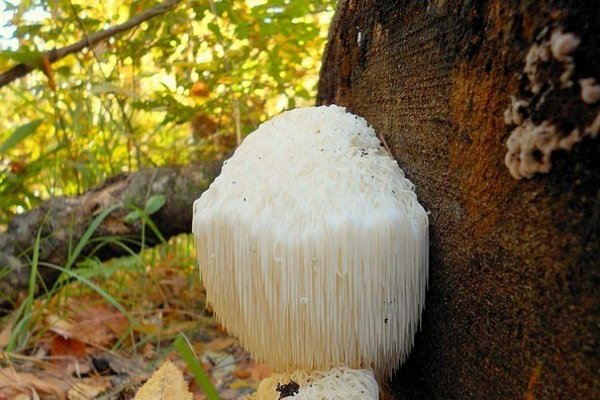
Hericium yellow
The cap of this mushroom is 15 inches, the color is red or orange-yellow. If you press it hard, it darkens, and the cap of the old mushroom also darkens. Fleshy, does not have a flat surface, dense and convex, as they grow up, they open up. The edges of the cap are bent, on the inside there are small thorns that break off easily, which is why the mushroom got its name.
The leg reaches 8 centimeters in height, the shape resembles a cylinder, wider at the bottom than at the top. The surface is dry and smooth at the same time. The color is the same as the cap - yellow, the older the mushroom, the darker the leg.
The flesh is brittle, white or yellow, when the mushroom ages, it becomes dark and hard to the touch. The smell is rich with a fruity note, and the old hedgehog has a bitter aftertaste.
When and where can you find it? In temperate climates in the Eurasian continent and America and throughout the territory from mid-June to October 13-20. Such a mushroom grows in coniferous and deciduous forests, among birches and near small bushes. May also form circles.
Why is the mushroom valuable? The yellow hedgehog contains amino acids, organic acids and mycosterol. The isolated repandiol has shown strong activity against cancer cells of any organ, especially the stomach. Repandiol prevents the proliferation of cancer agents because it binds the DNA of cancer cells to bridges.
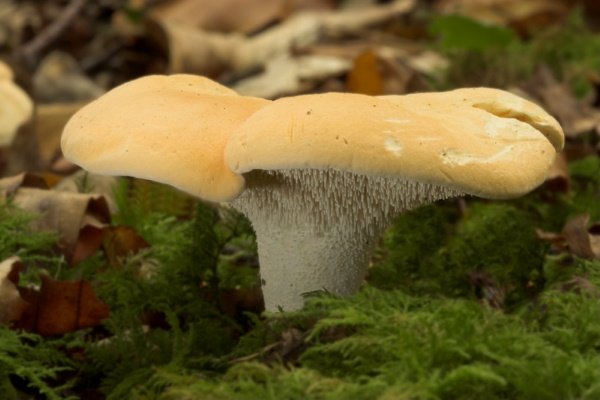
Coral hedgehog
The fungus grows like a bush, coral and branched. The color is white, less often yellow or flesh tint. Reaches 30 cm in transverse size. The coral hedgehog has two-centimeter thin and brittle spines.
The pulp is tasty, fragrant, firm and fibrous, and turns yellow as it grows.
Where and when does it ripen? You can find this type of mushroom in all forests of the Russian territory, in addition to the Northern part. Mushrooms grow in all forests, they settle on the dead bark of a tree, in the hollows of living trees, as well as on branches. In the southern region of Russia, the coral mushroom lives preferably on oak, linden and elm, and in temperate forests it loves aspen and birch. From June to October, you can pick mushrooms and prepare meals with them.
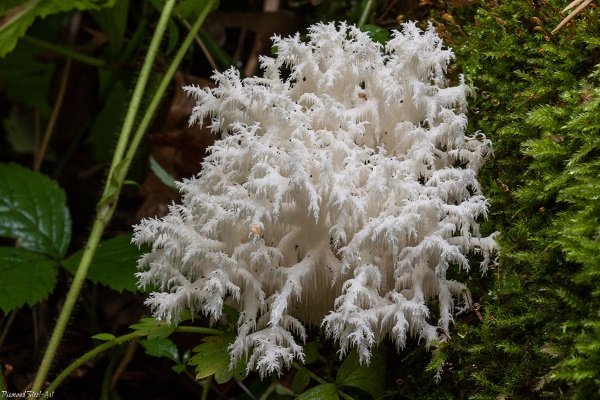
This mushroom can be used to prepare soups, fill various dishes, fry or dry.










